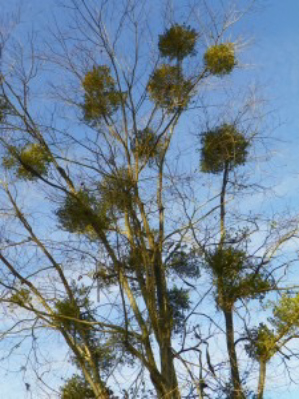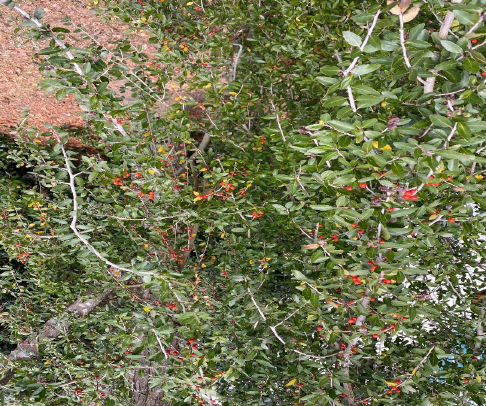Well, no, in fact, I didn’t know this. It got me thinking about mistletoe and how it became a cultural tradition associated with Christmas.
What is Mistletoe?
There are approximately 1500 species of mistletoe found worldwide; however, the two main types of evergreen shrubs with the common name mistletoe are American mistletoe (Phoradendron serotinum) and European mistletoe (Viscum album). They are hemiparasites on trees – instead of having roots in the ground, they send their roots into the branches of the trees, where they get water and nutrients. Because they can produce some  of their own food, they are not entirely dependent on their host trees. Other hemiparasites include Indian paintbrush, witchweed, velvetbells, and Indian sandalwood.
of their own food, they are not entirely dependent on their host trees. Other hemiparasites include Indian paintbrush, witchweed, velvetbells, and Indian sandalwood.
Mistletoe can grow on more than 100 species of trees. In my home state of North Carolina, it most often grows on pecan, hickory, oaks, red maple, and black gum. Mistletoe serves an important ecological function as food for several animal species and as an excellent location for nesting of certain bird species and owls
Mistletoe is often considered a pest that kills trees. However, since mistletoe grows relatively slowly, it rarely harms healthy trees. However, once a tree becomes heavily infested, mistletoe can cause stunting and other problems.
Mistletoe science and health
Mistletoe has traditionally been considered quite toxic, with many stories about poisonings from eating the berries or the leaves. However, it appears that the American mistletoe is less toxic than the European mistletoe.
One study of 1754 cases of children swallowing mistletoe during the Christmas season in the US found no symptoms or fatalities. Another study of 92 cases of young children who ingested 5-11 mistletoe berries reported no symptoms, and 3 of the 11 children who ingested 1-5 leaves reported only stomach upset. According to one report, “American mistletoe doesn’t deserve its highly toxic reputation.” However, let’s not forget about our beloved family pets. Mistletoe is fairly toxic to dogs and cats and can cause potentially serious effects and a very expensive trip to the veterinarian.
Alternatively, mistletoe has been used for a long time to treat a variety of ailments, including heart and respiratory conditions, to stimulate the immune system, and treat anxiety and stress. (There is no scientific evidence that it is effective for these uses). In Europe, European mistletoe has been given as a dietary supplement and sold as prescription drugs when given by injection. Currently, European mistletoe is promoted as a treatment for cancer. However, in the US, it is not approved by the FDA to treat cancer or any other disease. The National Institutes of Health (NIH) National Center for Complementary and Integrative Health has concluded that European mistletoe is not a proven cancer treatment and should not be used for cancer outside of investigative clinical trials.
How did Mistletoe Become Part of our Culture?
 Traditions around mistletoe go back for thousands of years. The Celtic Druids believed that mistletoe had sacred power to heal illness, protect against nightmares, and predict the future. They collected it during the summer and winter solstices and may even have decorated their houses with it. The Romans hung it over their doorways to protect the household and associated mistletoe with peace, love, and understanding. In the Middle Ages, mistletoe was associated with fertility and vitality.
Traditions around mistletoe go back for thousands of years. The Celtic Druids believed that mistletoe had sacred power to heal illness, protect against nightmares, and predict the future. They collected it during the summer and winter solstices and may even have decorated their houses with it. The Romans hung it over their doorways to protect the household and associated mistletoe with peace, love, and understanding. In the Middle Ages, mistletoe was associated with fertility and vitality.
Kissing under the mistletoe has its roots in ancient times, in the festivals of Saturnalia, year-end parties honoring Saturn, and conveniently enough occurring in late December in our current calendars. Mistletoe was thought to be associated with fertility. The Christmas tradition of kissing under the mistletoe was prevalent in Victorian England, primarily among servants. The tradition was that a man was allowed to kiss any woman standing under the mistletoe and that bad luck would come upon any woman who refused the kiss. It was also said that the woman who refused the kiss would not expect any marriage proposals for the following year. A variation on this tradition was that the man would remove a berry from the mistletoe for each kiss, and the kissing did not stop until all the berries were gone. (Apparently, some men ate the berries, which caused stomach upset and even poisonings).
Today, mistletoe is hung up as a Christmas decoration, and the tradition is that any couple caught standing under it should kiss. Over the years, mistletoe has made its way into popular music with songs such as the 1958 hit “Rockin’ Around the Christmas Tree,” referring to couples wanting to stop and kiss beneath the Christmas tree, to the more current 2020 song, “Under the Mistletoe” by Kelly Clarkson and Brett Eldredge.
Conclusions
I would like to wish everyone a very berry Christmas and please remember that even though the American mistletoe is not as toxic as the European mistletoe, watch your toddlers and not consume too many berries after a little too much eggnog - mistletoe can be used for kissing but not for treating diseases.




